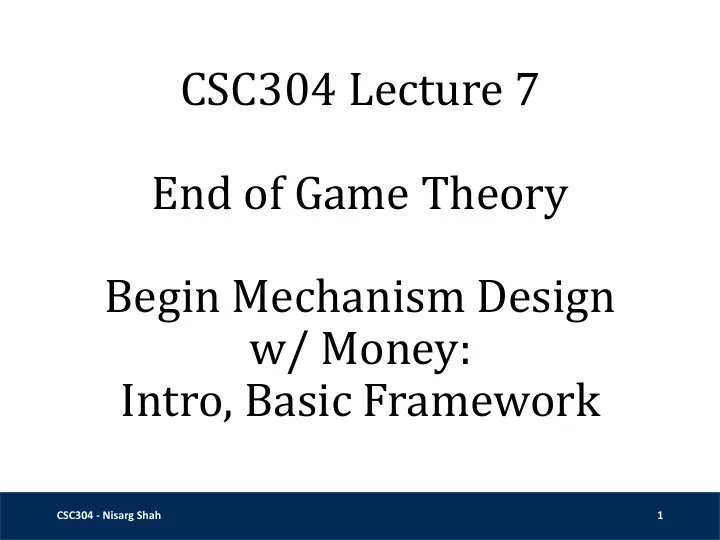

CSC304 Lecture 7 End of Game Theory Begin Mechanism Design w/ Money: Intro, Basic Framework CSC304 - Nisarg Shah 1
Game Theory Recap • Normal form games ➢ Strictly/weakly dominant strategies ➢ Iterated elimination of strictly/weakly dominated strategies ➢ Pure/mixed Nash equilibrium ➢ Lots of examples ➢ Nash’s theorem ➢ Finding pure NE using best response diagrams ➢ Finding mixed NE using the indifference principle CSC304 - Nisarg Shah 2
Game Theory Recap Price of Anarchy (PoA) Price of Stability (PoS) • Worst NE vs social • Best NE vs social optimum optimum max social welfare max social welfare min social welfare in NE max social welfare in NE max social cost in NE min social cost in NE min social cost min social cost PoA ≥ PoS ≥ 1 CSC304 - Nisarg Shah 3
Game Theory Recap • Cost Sharing Games ➢ Potential function ⇒ existence of a pure NE ➢ PoS = 𝑃(log 𝑜) , PoA = Θ 𝑜 • Congestion games ➢ Braess ’ paradox • Zero-sum games ➢ The minimax theorem • Stackelberg games ➢ Security games CSC304 - Nisarg Shah 4
Mechanism Design • A principal who wants the agents to choose certain actions • Designs the payoff matrix such that rational agents will choose the desired actions • E.g., in the prisoner’s dilemma, the police setting the payoffs for the four outcomes “betray” and “silent” to get both agents to betray CSC304 - Nisarg Shah 5
Mechanism Design • Formally, a set of outcomes/alternatives 𝐵 • Each agent has preferences over 𝐵 ➢ Cardinal values: 𝑤 𝑗 ∶ 𝐵 → ℝ ➢ Could also be ranked preferences (later!) • The principal wants to implement an outcome 𝑏 ∗ ➢ Social choice theory: “Which outcome is socially good given agent preferences?” ➢ Various metrics: efficiency, fairness, stability, revenue, … CSC304 - Nisarg Shah 6
Mechanism Design • For now, we focus on social welfare maximization ➢ 𝑏 ∗ ∈ argmax 𝑏∈𝐵 σ 𝑗 𝑤 𝑗 (𝑏) • But agents want to maximize their own value ➢ Might try to feed bad information to the principal • Key advantage: the principal can charge payments CSC304 - Nisarg Shah 7
Mechanism Design • Focus on direct revelation mechanisms • Principle declares a pair (𝑔, 𝑞) 𝑜 ➢ Once all agents report their valuations 𝑤 = 𝑤 𝑗 𝑗=1 ➢ The outcome is 𝑔(𝑤) ➢ The payment vector is 𝑞(𝑤) : agent 𝑗 pays 𝑞 𝑗 (𝑤) • Utility to agent 𝑗 is quasi-linear ➢ 𝑣 𝑗 𝑤 = 𝑤 𝑗 𝑔 𝑤 − 𝑞 𝑗 (𝑤) CSC304 - Nisarg Shah 8
Mechanism Design • Not only that, we want… ➢ to choose 𝑔 𝑤 = argmax 𝑏∈𝐵 σ 𝑗 𝑤 𝑗 (𝑏) ➢ the agents to correctly report their 𝑤 𝑗 • You all tell me the truth. I’ll compute the social best outcome. ➢ Yeah, right. • How do we get the agents to tell the truth? ➢ Use the 𝑞 𝑤 correctly! CSC304 - Nisarg Shah 9
Mechanism Design • Dominant strategy incentive compatibility (DSIC) ➢ It should be a dominant strategy for the agent to report truthfully • Bayes-Nash incentive compatibility (BNIC) ➢ The agents share a common prior : each 𝑤 𝑗 is drawn from a distribution ( 𝑤 𝑗 ~ 𝐸 𝑗 ) ➢ Agent 𝑗 knows 𝑤 𝑗 , but takes expectation over other 𝑤 𝑘 • The revelation principle (in short) ➢ Any outcome that can be achieved as dominant strategy / Bayes-Nash equilibrium can be achieved by a direct revelation mechanism. CSC304 - Nisarg Shah 10
Mechanism Design • Recap ➢ We want to maximize social welfare ➢ We want to do so using a direct revelation mechanism ➢ We want it to be truthful ➢ The last two are w.l.o.g. given the revelation principle • Wait. Why do we want to maximize σ 𝑗 𝑤 𝑗 (𝑏) ? ➢ What about payments? We don’t really care about them. ➢ Alternatively, you can cancel them out if you add the principal/auctioneer as an agent in the system ➢ σ 𝑗 𝑤 𝑗 𝑏 − 𝑞 𝑗 + σ 𝑗 𝑞 𝑗 = σ 𝑗 𝑤 𝑗 (𝑏) CSC304 - Nisarg Shah 11
Recommend
More recommend